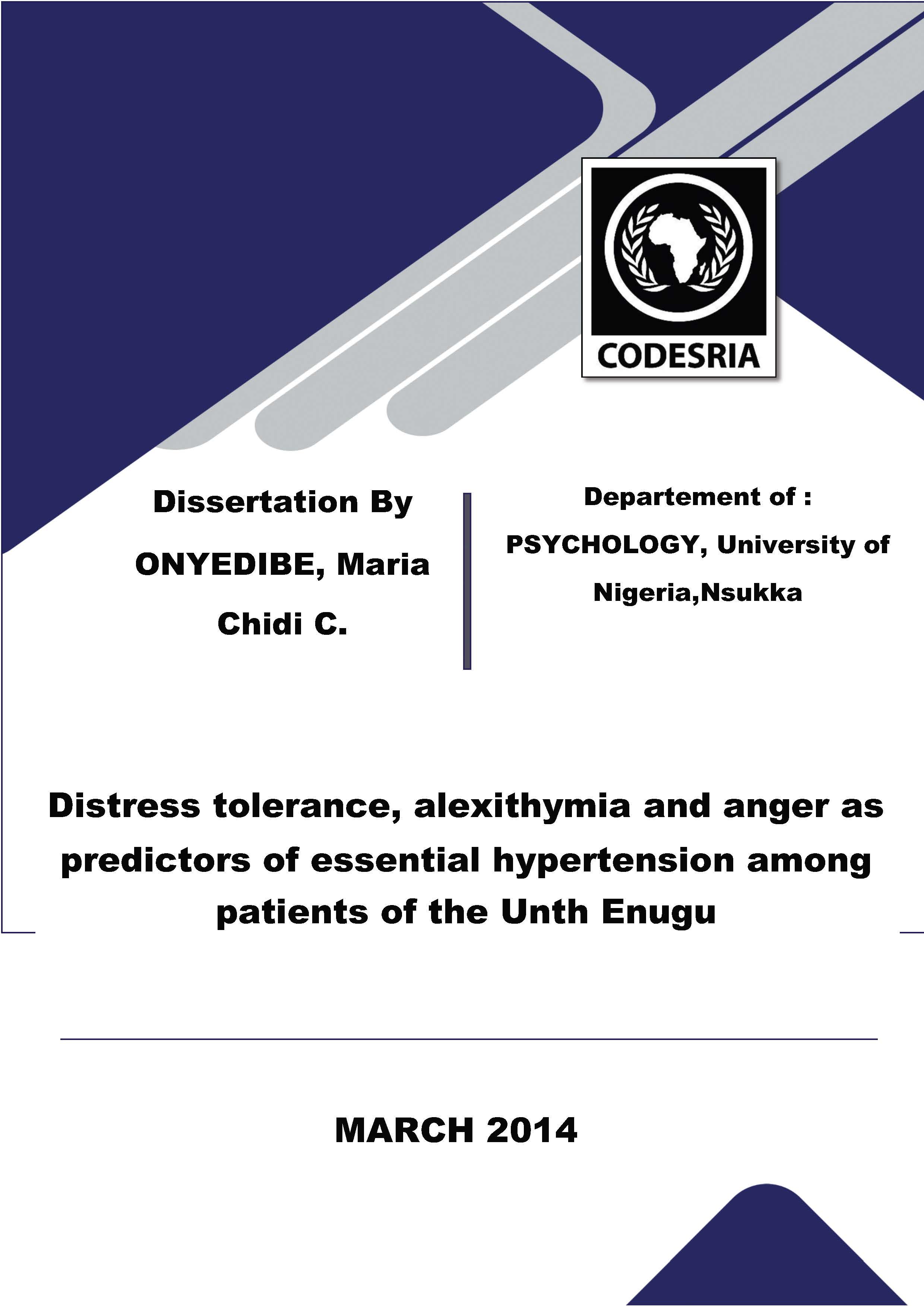Distress tolerance, alexithymia and anger as predictors of essential hypertension among patients of the Unth Enugu
Keywords:
Cardiovascular diseases, occupational diseases, hypertension, distress, Alexithymia, anger, blood pressure, NigeriaSynopsis
This study investigated the relationship between distress tolerance, alexithymia, anger and
essential hypertension among patients. Three hundred and ten patients drawn from the
Cardiology Units, Surgical out Patients and General Outpatient Department of the UNTH
participated in this study. They comprised men (156) and women (153) who were aged 20 - 80
years. Distress Tolerance Scale (Simons & Gaher 2005) was used as a measure of distress
tolerance, Toronto Alexithymia Scale (Bagby, Parker, & Taylor, 1994) was used as a measure
of alexithymia while Novaco Anger Inventory-Short version (Devilly, 2005) and Anger
Expression Scale (Spielberger, Johnson & Jacobs, 1985) were used to measure anger experience
and anger expression respectively. Five hypotheses were tested: Distress tolerance will not have
a significant relationship with essential hypertension; Alexithymia will not have a significant
relationship with essential hypertension; Anger experience will not have a significant
relationship with essential hypertension; Anger-in will not significantly predict essential
hypertension; Anger-out will not have a significant relationship with essential hypertension. The
result of the hierarchical multiple linear regression analysis indicated that distress tolerance was
a significant predictor of essential hypertension (P= -.28, t= -.6.26, p<.001). Alexithymia
significantly predicted essential hypertension (P= .19, t= 4 .41, p < . 001 ), Anger experience was
also shown to be a significant predictor of essential hypertension (P= .13, t= 3.22, p < .001).
Anger-in was also shown to be a significant predictor of essential hypertension (P= .28, t= 36.89
p < .001). Thus the four hypotheses were rejected. However and anger-out did not have a
significant relationship with essential hypertension@= .02, t= -.62, p<.54). The implications of
the findings as well as summary of the findings were discussed.
Downloads
References
Abengowe, C.U. (1987). Serum uric acid values, hypertension and alcohol consumption in men. Trop d'annees de card-pla, je suis deshumanise, 13, 109-111.
Alexander, F.G. (1939) Emotional factors in essential hypertension: presentation of a tentative hypothesis. Psychosomatic Medicine, l, 175-179.
Bagby, R M., Parker, J. D. A., & Taylor, G. J. (1994). The twenty-item Toronto Alexithymia Scale-I. Item selection and cross-validation of the factor structure. Journal of Psychosomatic Research, 38, 23-32.
Bar-On, Reuven, Parker, & James D.A. (2000). The Handbook of Emotional Intelligence: Theory, Development, Assessment, and Application at Home, School, and in the Workplace. San Francisco, California: Jossey-Bass.
Breakwell, G. M. (1997). Coping with Aggressive Behaviour. Leicester: British Psychological Service.
Burt, V.L., Whelton, P., Roccella, E.J, Brown, C., Cutler, I.A., & Higgins, M. (1995).
Prevalence of hypertension in the US adult population. Results from the Third National Health and Nutrition Examination Survey, 1988-1991. Hypertension, 25, 305-313.
Callister, R, Suwarno, N. 0., & Seals, D. R (1992). Sympathetic activity is influenced by task difficulty and stress perception during mental challenge in humans. Journal of Physiology, 454, 373-387.
Cappuccio, F. P, Micah, F. B., Emmett, L., Kerry, S. M., Antw~ S., Martin-Peprab, R, Phillips, RO., Plange-Rbule, J., & Eastwood, J. B. (2004). Prevalence, detection, management, and control of hypertension in Ashanti, West Africa. Hypertension, 43: 1017-1022.
Carretero, 0. A., & Oparil, S. (2000). Essential hypertension, Part I: definition and etiology. Circulation 101, 329-35.
Carson, R C., Butcher, J. N., & Mineka. S. (2001). Abnormal Psychology and Modem Life. Boston: Allyn & Bacon.
Chaweewon, B., Khin, L. M., Oranut, P., & Tassanee, S. (2011). Risk factors of hypertension among rural Thais. The Southeast Asian Journal of Tropical Medicine and Public Health, 42, 1-21.
Chobanian, AV., Bakris, G. L., Black, H. R, Cushman, W. C., Green, L. A., & Izzo, J. L, (2003). The Seventh Report of the Joint National Committee on Prevention,
Detection, Evaluation, and Treatment of High Blood Pressure: the INC 7 report Journal of the American Medical Association, 289, 2560-2572.






